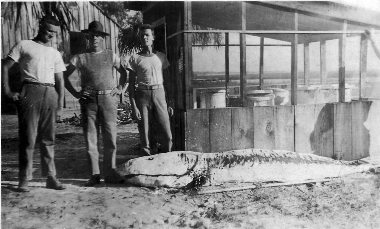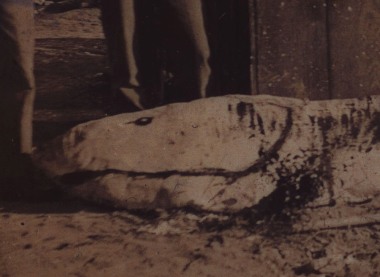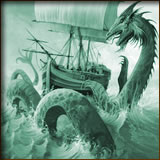Mystery Fish Continues
Posted by: Loren Coleman on August 25th, 2006
With so many new people here, it’s time to check in with an old favorite of Cryptomundo.
The Mystery Fish postcard, first noted here on November 29, 2005, has never been identified, as to exact location or species. Several thousand new readers have found their way to Cryptomundo since November, so here’s a quick revisit to that photographic mystery.
(Click on image to see full size version, enhanced by shockbeton)
Due to research on the type of postcard it is, there was a determination, thanks to Cryptomundo readers, that this specific item would have been produced between 1904-18.
The location seems to be in the Pacific; perhaps it was taken in the Philippines. Or maybe even Florida? Someone said this might be during WWI, in the south of France, because of the uniforms, but what of those palm trees? Where are these trees found? Can you identify the kind of trees? I don’t know where this was taken. Do you?
Due to popular demand, here is a roundup of all four (+ one) direct links to the "Mystery Fish Photo" entries in the Cryptomundo.com blog, which were posted in 2005 and 2006:
"Name the Mystery Fish Continued"
Reactions continued, as well, into 2006: “Mystery Fish Revisited”
Almost three hundred comments, most of them extremely thoughtful and detailed, can be found at the above noted entries, and yours are welcome anew, here, below. To date over 1,000,000 views of the Cryptomundo “Mystery Fish” photo have occurred.
(Click image for full-size version, provided by Todd DiLaMuca)
+++Date of the Postcard++++
The earlier discussions noted the date was between 1904-1918 for this postcard. For example, in this hyperlinked blog (please click), the entire back of the postcard is pictured. Various pieces of research exactly determined that the diagnostic direction of the triangles give forth with a specific range of when these postcards were produced. While the men and the fish could have been photographed before 1904, they could not have been photographed and appeared on this card after 1918.
The window of time for this event is, therefore, most probably, between 1890 and 1918. But certainly, this photograph was not taken anytime after 1918.
About Loren Coleman
Loren Coleman is one of the world’s leading cryptozoologists, some say “the” leading living cryptozoologist. Certainly, he is acknowledged as the current living American researcher and writer who has most popularized cryptozoology in the late 20th and early 21st centuries.
Starting his fieldwork and investigations in 1960, after traveling and trekking extensively in pursuit of cryptozoological mysteries, Coleman began writing to share his experiences in 1969. An honorary member of Ivan T. Sanderson’s Society for the Investigation of the Unexplained in the 1970s, Coleman has been bestowed with similar honorary memberships of the North Idaho College Cryptozoology Club in 1983, and in subsequent years, that of the British Columbia Scientific Cryptozoology Club, CryptoSafari International, and other international organizations. He was also a Life Member and Benefactor of the International Society of Cryptozoology (now-defunct).
Loren Coleman’s daily blog, as a member of the Cryptomundo Team, served as an ongoing avenue of communication for the ever-growing body of cryptozoo news from 2005 through 2013. He returned as an infrequent contributor beginning Halloween week of 2015.
Coleman is the founder in 2003, and current director of the International Cryptozoology Museum in Portland, Maine.












OK – here’s the break. Searching for all the text on the back of the card (which is “POST CARD”, “CORRESPONDENCE HERE”, “NAME AND ADDRESS HERE” and “PLACE STAMP HERE” (and “AZO” if you include the border for the stamp) yielded a few interesting web links.
Firstly, the Historic Pelham website links to two antique postcards with the exact same design. The first shows Cliff Avenue and is postmarked 1909.
The second shows the Little Red Church of Pelham Manor from circa 1910.
Next, we have a reference to a 1911 postcard with matching text at the Oregon State University Library.
So far so good with the American marines and the American creator of the font face, we now have three identical postcard designs, all with American postmarks.
(The fact that the font face was created in 1901 already reduces the date range at the end of this blog by 11 years, from 1890-1912 to 1901-1912 and the three identical postcards marked 1909, 1910 and 1911 indicate we may be looking around the turn of that decade)
But now for the jackpot – we have to head off shore, and to the Nicaragua Living online forum.
On this page you will see a postcard, again with the matching text, this time depicting a beach scene with various buildings and palm trees in the background.
On the front of the postcard is the text “San Juan Del Sur Nicaragua”. The owner of this postcard bought it on Ebay and was looking for information about it.
A contributor by the name of “RPPC 1912” has this to say:
This is one in a series of about 40 or so from 1912 … There are 2 others from this series taken in San Juan Del Sur that I’ve seen. One shows the street (San Juan) and another was taken from another vantage point. Writing is part of the photo and was etched on the negative and contact sheet.
These cards were sold to US Marines who then sent them back to the States. Many of the cards in the series have Marines shown in the Postcards.
This series of cards comes with good story…
Civil strife took over Nicaragua in 1911 and the US Marines were sent in. They took over customs, reorginized finances, and kept a legion until 1925 only to have to return a year later. Eventually US Marines defeated these insurrectos in a time before CNN and video cameras.
There were insurrections and massacres in Leon and other towns. Insurrectos would come into towns or villages and murder anyone who supported the US business interests like fruit and such. Politicians were also targeted along with their families. This time was one of the lowest points in Nicarguan history.
Eventually Sandino consolidated this lot and became the defacto leader, however US Marines could never catch him.
All things considered, I would say there is a high liklihood that our cryptid in question is on one of the postcards from the San Juan Del Sur series of 1912.
We have a date, we have a location, and now all we have to do is find out what fish live there.
Barracudas fit the general body shape, have the same striations (stripes) and diminutive fins, but don’t have such a heavy-set head.
Sea-pike fit the description for all the same reasons.
Wahoo also fit the bill, but in all three cases our cryptid would have to be a world-record breaker to be one of these.
You can compare various big-game fish from around the world at this international spearfishing blog.
Any fisher or biologists familiar with the biota from Nicaragua? Not many pieces left in this puzzle, I hope!
Chris.
At first I thought maybe it was a “snakehead” as in the large freshwater fish, but upon closer examination of pictures of this fish, the eye placement and mouth seem wrong for a snakehead. The two things that baffle me are the eyes and lack of front fins. The eye is an odd shape for a snakehead or shark, unless as some have suggested, it’s painted on. The fins, even if they were cut off, I would think there would be some sign of this. Wierd. I definately think it was gutted, but where are those fins?
Apart from it having no visible legs, it looks more than a little like one of those big prehistric amphibians, with names likes “Eryops,” than can be seen on the first pages of even the simplest dinosaur books, which might contradict my next remark. That seems like a pretty strange choice for a hoax (if that’s what it is), as opposed to something with a “plesiosaur” look (since plesiosaurs, like dinosaurs, were already such a part of popular culture early on).
Look at the close up of the head. The features look too geometric and blocky judging by the shadows that it throws. It looks like shaved styro-foam. Splashed with some kind of algae or sea weed. The only problem with what I just said is that the rest of the body seems to flow and remain rather streamlined, like most aquatic creatures.
After a fresh look:
Assuming it’s genuine and does not depict a created or highly modified creature, we have a fish. Since there’s no clear “twist” to match the seemingly upright head to the body laying on its side, I suggest were’ s seeing it from the top and the “mouth” is a wound (boat propellor, maybe?). The eye is indeed an eye, but it’s the fish’s right eye, seen from a dorsal POV. If someone cut off the dorsal fin as a sovenir, then we’re looking at it from the top. That the dorsal fin is worth taking implies a shark, even though the rest of it has, as someone pointed out, a bit of a tarpon-like look.
That’s a good idea MattBille, but I would think a cut off dorsal fin would leave some sort of obvious wound. The wound that appears to be on the creature’s apparent neck just doesn’t seem to be in the right position for a dorsal fin if we are in fact looking at it from the top. But it’s definately good to be thinking outside of the box on this one. Even though there is no way we are ever going to conclusively know what it is, it makes for very interesting speculation.
I also strongly think this fish has been skinned as the surface of the body has that type of look to it. If that is the case, then there is definately evidence of lateral lines there, which leads me to believe that it is indeed on its side. It’d be interesting if anyone could dig up some pics of what different fish look like skinned and with fins cut off for comparison.
Looking at it from Mattbille’s perspective makes the head appear very shark-like, but the body still doesn’t match at all. Still, his perspective may indeed be right, especially if the body form is somewhat laterally compressed. Nice job!
This photo is a tough one. I was just looking at photos of alligator gar and although the head seems wrong, it could be similar if we are looking down on it as Mattbille said. The body sure seems very similar to that of a gar’s and if it were skinned, that would explain the markings. Hmmmm. The size is also large for a gar. Gars are not my field of expertise, so does anybody know if that is a possible candidate?
There was also a US military presence in the Philipines during this period. (not to mention other tropical places) Depending on how widespread those kinds of postcards were, the picture could be from there. And palm trees will grow in various places in the southern US. Nicaragua can be added as a possible location, but I’m not sure you can rule many other places out with any certainty.
As far as the mystery animal being a fish there is still little evidence of gill openings or slits, and if the argument is that the animal is skinned there is little evidence of the underlying gill structures.
That is a good observation. Where are those gills slits? If it doesn’t have them, then it would have to be an air breather which and that would count out a lot of the other ideas of it being some sort of shark. Maybe a type of large lungfish? It just doesn’t look very reptilian to me at this point. Curiouser and curiouser.
I would think if it were a shark there would be -some- evidence of fins, particularly that telltale dorsal fin. Yet this creature has nothing. I’d say the Crassigyrinus looks to be as good a candidate as anything for this mystery cryptid. Great detective work so far everyone! By far one of the more fascinating Cryptomundo articles I’ve read to date. One other note though regarding a previous comment — was styrofoam invented yet in the 1910’s?
I was thinking styrofoam or some sort of artificial alteration of the head at first too, but it seems like it would look more fake if that were the case, something along the lines of a Barnum type Fiji mermaid sort of look. If it is really styrofoam or something, they did a good job with it. I don’t think the intelligent posters here would be so easily fooled by that.
Seriously, I don’t see why there would be any reason for this photo to be fake.
Secondly – look at the tail. You can see the caudal peduncle – the junction between the caudal (or tail) fin itself, and the body. It is laterally compressed. In other words, the body is definately on its side and the tail matches a fish, not a whale.
Someone wrote “we will never know”. To the contrary – if we can identify the people, then perhaps locate family, friends or written evidence such as a journal, diary or letter, then we may well find out.
Regarding the Philippines and Nicaragua – it simply strikes me as odd that when you search for the exact same text, you get only a handful of matches, one of which is claimed to be from a series of 40 taken in Nicaragua which often showed the marines in the photo.
Postcards are collectable. People document antique postcards. I still think the Nicaraguan connection is the strongest one we have.
If there are any military researchers amongst us, they should start finding the lists of names of people who went to San Juan Del Sur.
Chris.
looks like those boys butchered the fins off a shark…. we used to buy postcards when we stayed at the best western of giant chickens that are more convincing!
As far as the “tail” end is concerned, I don’t see much in the way of fins – pectoral fins, dorsal fins, caudal fins, tail fins – I don’t see much evidence of any of them. Or scars where they used to be.
I’m basically of the opinion that the right side of the creature is where it was severed from the rest of the body. From what I can tell we are only looking at part (only the head and neck) of a larger animal.
Re: Styrofoam. Remember this is allegedly around the turn of the century and a lot of the things that could be used to hoax something like this now were not in existence then.
It was taken so long ago that even if we did pin down the location and the exact place, would anyone remember this photo in this context? Possibly these people didn’t even realize what a find they had? People might have found cryptozoological finds and due to ignorance just wrote it off as “some sort of fish.” Add to that the time that has passed, lack of living witnesses, lack of DNA samples, and what not, and I come to the conclusion that it will be very hard to conclusively identify this creature beyond a shadow of a doubt. I don’t say impossible, but quite difficult. I would gladly stand corrected on this. But then again, who knows, maybe this is a cryptid that the people in that area know of very well. I’m just throwing ideas out here, searching for the truth.
I sure think it would help though if someone can pinpoint this location. Youcantryreachingme seems to have done his homework and could be on the right track.
shovethenos – you mentioned not seeing much in the way of a tail fin.
After a million hits to the various threads, we’re still debating what *kind* of animal this is – bony fish, shark, mammal, etc.
I spent a bit of time enlarging and enhancing the tail section of this animal, and overlaying it with some lines to show what I’m seeing.
You can see the results at my website, Where Light Meets Dark.
As noted above in the commentary here, I conclude from the tail that it’s a bony fish; but at the same time, if I were looking at the head end only, I’d say it was a shark.
Looks very much like a shark, on its side, with its upper side toward the camera. Imagine it as if you were in the air, looking down at it in the water.
The “mouth” which some have alluded to isn’t a mouth at all. I would guess it is a combined blood streak and injury from being gaff-hooked, probably by the same instrument that is in the foreground. There seems to be a good candidate for a dorsal fin under the gaff-pole.
Seems to be a trophy picture of a dead shark, but in an unusual pose. I’d surmise that with such a nasty looking and big fish, the men weren’t keen on handling it to pose it more favorably. Thus they took a picture of it as best they could, probably with the fish lying in the same position it was dragged to land in.
The thing that doesn’t sit well with me as far as the shark theory goes is “why bother”? It is not very big for a shark, to be honest, especially a tiger shark, like a lot of people seem to think. So why make a postcard of a couple of guys standing around a pretty mediocre sized shark? I wonder why they would make a big deal about this particular specimen? It makes me wonder.
Someone commented earlier that the fish’s head looks like it’s papier mache- I personally think the whole thing looks like it could be made of papier mache. In my opinion, the markings on its sides look like they were made by a paint brush on a rough surface, and those eyes are appear to be painted on.
How about a large cousin of the electric eel, Electrophorus electricus?
In more detail, my hypothesis follows:
1) Assumptions
1a) The photograph is genuine, and the subjects in the image do not involve any sort of illusion, such as period costumes, props, or scenery.
1b) The star of the picture is a bony fish.
1c) The fish lies mostly on its right side, though the head may be at least partly propped up with another object, such as the one fellow’s boot (“OK, push a little to the right; now a little forward.”)
1d) No fins of any significant size have been removed from the fish, either before or after its meeting with the men in the photo.
1e) No other organs of any significance have been removed from the fish, or if they have, then their removal has not significantly altered its overall shape or characters.
1f) The “upward bend” of the “mouth” is actually the gill cover opening, and only the “front 1/4” of the “mouth” is the mouth. The dark line connecting these two features is the injury created when the bill hook used to pull the fish tore through its “cheek” from gill cover to inner edge of mouth.
2) Arguments in favor of “relative of electric eel” hypothesis
2a) The overall shape of the head and body match reasonably well, except that the fish in the picture is more “stout” and less elongated.
2b) Tiny pectoral fins like those of an electric eel might not be visible, especially if there is an injury or bit of shrubbery obscuring that part of the fish.
2c) The long “ventral fin” (if that’s the proper term) of a creature like the electric eel could be folded under its body, thus giving the fish the appearance of being completely finless.
2d) Electric eels are native to swamps and marshes of South America, so it is not beyond the bounds of reason to suggest that a larger relative could exist in Nicaragua.
2d) The size of the fish, while impressive for a presumed fresh-water creature, would not break any kind of record.
2e) The expressions of the men might not arise from amusement, as suggested by one person, but from discomfort and mistrust, particularly if one or more people were injured or killed by the creature’s electric shocks.
3) Some potential problems with the “relative of electric eel” hypothesis
3a) “While the length of our subject is not excessive for an electric eel, its depth of body is substantially greater, yielding a different aspect ratio and much greater mass, perhaps 20-50 times that of an electric eel.” This problem essentially excludes the electric eel per se, but I know of no biological reason that would prevent a related genus or species from growing to this size. The “tail” of an electric eel contains mostly the specialized muscles used to create electric potentials, but a thicker creature may not need to create *larger* shocks to stun its prey than the electric eel does, and so might reasonably get by with a proportionately smaller electric apparatus.
3b) “The barred coloring of our subject resembles that of open-water fish more so than that of electric eels, which tend toward simpler top/bottom countershading.” However, a different ecological niche would require different camouflage.
3c) “Electric fish of such large size certainly would have attracted the attention of scientists by now.” To some extent, this argument may be applied to any cryptid, and is usually countered by suggesting that the creatures are rare or elusive, or that scientists from industrialized countries have ignored local knowledge of such creatures. In particular, if these fish were native to a shallow swamp or marsh that was later drained to make way for agriculture, used as a landfill, or contaminated with mine tailings, the poor creatures easily could have gone extinct in anonymity.